Renowned photographer Robert Frank, most well known for his book "The Americans" (1958), is known for not being afraid to reveal the dry, harsh reality of the lives of everyday people, himself included. His photographs capture moments of life in the most realistic way, and unlike his predecessors or contemporaries, Frank daringly reveals a facet of life that is not always beautiful, but bearable with ephemeral moments of joy. The current exhibition "Robert Frank: Books and Films, 1947–2017," the first to display Frank's work in the context of his life as an artist, echoes the photographer's ideals and introduces the life of a professional artist into the lives of Tufts students.
Displayed around Tisch Library, the exhibition is impossible to miss for anyone who visits the library. Everyone who enters the building is welcomed by multiple signs describing the ongoing display, and passers-by are invited to grab a copy of the exhibition's 64-page catalog.
The show features a wide range of Robert Frank's work, visually exploring the artist's life as a photographer and filmmaker from his earliest days. The collection includes seven of Frank's short films directly projected onto a wall, 24 photo books Frank published with Gerhard Steidl hung from the ceiling, and 26 photo sequences, including pages, photographs and scripts from his books and the contact sheets for his book "The Americans," printed on newsprint sheets.
Much of the exhibition's beauty comes from the uninhibited and unconventional nature of Frank's photographs, and from his ability to narrate in sequences. To be specific, some of his photos don't make much sense as disparate elements. Something — whether it be the focus, balance or angle — feels off when viewed individually. However, when seen together in a larger context, the photographs mesh perfectly, acting like fragments of a well-orchestrated montage.
Frank's photos are also special, according to professor of photography Mike Mandel, for the way they portray how Frank's personal life affects the way he sees the world.
"He's kind of intersecting his own personal life with social life and from what I saw [from the exhibition] there is a lot going on here," Mandel said. "There's pictures of his family, there's pictures of what's going on around the world. He is probably one of the most crucial artists who [has] enabled so many other artists to ... use their ways of personally perceiving the world and make pictures in that way."
Mandel also said that he appreciates the exhibition for reflecting the artist's philosophy.
"[The exhibition is] an interesting bargain that [Steidl] made with Robert Frank to be true to Frank's ideals of not making [his] photography into [a] commercialized, precious object and to make something people can still appreciate on [an] aesthetic level because he's such a good printer and he can make really decent looking prints," Mandel said.
This notion is also mentioned in one of the statements hung up on the wall. The statement also explains that the prints are destroyed after each installation of the traveling exhibition.
"Conceived by Robert Frank and Gerhard Steidl, this exhibition shows Frank's work in photos, books and films in a direct accessible manner. Frank's images are printed on sheets of newsprint ... Each exhibition is to be disposed of after display, thus circumventing the normal cycle of speculation and consumption in the art market," the statement reads.
Jennifer Burton, professor of practice at the Department of Drama and Dance, spoke on the exhibition's accessibility and encouraged students to take the time to look at what's available in their everyday lives.
"This is a tremendous thing that Tisch [Library] is doing to allow the arts to enter our everyday spaces. And [Steidl and his team] have done it in such a way that it's been printed on this newspaper and printed on these materials that it can be all over the library and not protected," Burton said. "It's available. It's incredibly democratic — this exhibit — in conception. And so taking advantage of that — just taking a few minutes to stop in your life and look [at] what's being offered can offer [a] tremendous amount in your life."
The exhibition, sponsored by the Steve Tisch Foundation, Steidl and the Richard Ehrlich Family Foundation, has been open to the public since Oct. 7 after a private opening ceremony, and it will remain on display until Nov. 5.
'Robert Frank: Books and Films, 1947–2017' offers a window into an artist's life

'Robert Frank: Books and Films, 1947-2017' features Robert Frank's contact sheets for his book 'The Americans' (1958).





